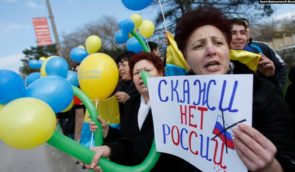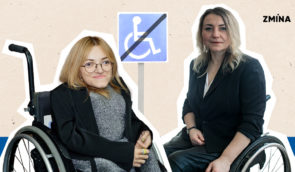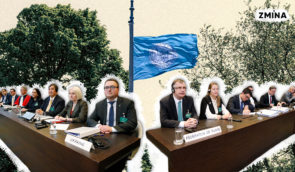‘Genocide’ at ATO checkpoints – queues grow threefold
The number of people striving to cross the demarcation line in eastern Ukraine grew twofold or threefold in mid-October. The human rights activists demand to increase the capacities of the “pass entry system” to ensure appropriate crossing the line.
“Two days in queues with mud and the cold around. People feel anger, aggression, despair. The worst thing is three degrees below zero at night. Do you imagine how it is difficult to spend a night with children in a car in sub zero temperatures? Do you imagine it lasting for two days?” Coordinator of the NGO “Donbas SOS” Oleksandr Horbatko tells about the mood of Ukrainians at the demarcation line, the Human Rights Information Center correspondent reports.
The queues at the entry-exit checkpoints have been formed because of the rumors that nobody will be able to enter or leave the temporarily occupied territory during the elections and due to the need to reissue documents to get social benefits and pensions.
This is the opinion of first deputy chief of the State Border Guard Service of Ukraine Vasyl Servatiuk. However, the situation has been aggravated by the small number of the entry-exit checkpoints. According to him, the Ukrainians from Donetsk and Luhansk regions leave only through “Zaitseve” and “Novotroitske” entry-exit checkpoints.
“There are a lot of people also because they need warm clothes for autumn and winter. Some want to visit their house, tape up the windows for winter and go back. Many go to buy food,” Oleksandr Horbatko says.
‘Genocide’ instead of improvement
The State Border Guard Service representative is happy that the government has increased the capacity of the checkpoints.
For example, if earlier there were up to ten automated workplaces at the “Zaitseve” entry-exit checkpoint, today 18 employees check the documents there. Twenty-four automated workplaces have been recently opened at the “Novotroitske” entry-exit checkpoint.
“For example, October 27, the “Novotroitske” entry-exit checkpoint in Donetsk direction registered 8,830 people and 3,150 vehicles from 8:00 to 17:00. The “Zaitseve” entry-exit checkpoint registered 5,050 people and 1,100 vehicles,” Vasily Servatiuk said. He compares these data with the figures of the “Krakovets” checkpoint on the Ukrainian-Polish border, where the guards allowed 10,146 people and 4,349 vehicles pass a day.
However, such efforts of the authorities are not quite enough, the human rights activists argue.
“The video showing a man who captures the queue on camera at a speed of ten kilometers per hour in one direction appeared on the web. It lasted nine minutes. It shows an unbelievable number of cars,” Oleksandr Horbatko is outraged.
According to him, the Ukrainians who try to cross the border describe the inaction of the authorities as “genocide.” They move 200 meters forward in two hours, for example.
“They do not know whom to resort to in this situation. If the Border Service receives a call from people asking to remedy the situation, the call is redirected to the headquarters of anti-terrorist center at the Security Service, and the Security Service redirects it back to border guards,” the coordinator of the “Donbas SOS” says.
Oleksandr Horbatko says that the queue movement is being slowed down especially after the border guard rotation and due to poor technical condition of the devices used at the checkpoints.
Solution to problem
The experts call on the OSCE and all the parties of the Trilateral Contact Group in Minsk to discuss the opening of additional corridors for civilians.
“There should be more corridors, not just six. Let’s give people the opportunity to move across the country. If we lose the information war, we may at least inform them about what is going on here live,” Oleksandr Horbatko.
The Border Guard Service has already appealed to the National Security and Defense Council and the ATO Headquarters to consider the possibility of restoring or opening the new entry-exit checkpoints in Donetsk and Luhansk regions.
However, it’s not so simple to open new checkpoints as they may start to work only after all the security issues are carefully examined, Vasyl Servatiuk explain.
The human rights activists recommend that the entry-exit checkpoints should work around the clock as no shooting has been recorded near the checkpoints.
The bus services will also help to reduce the queues. However, this solution requires the tender for carriers and prevention of overpricing, Oleksandr Horbatko notes.
The experts urge the Emergency Service of Ukraine to set up tents and create necessary conditions so that people could stay there during the cold season.







